JEEP RENEGADE 2014 1.G Owners Manual
Manufacturer: JEEP, Model Year: 2014, Model line: RENEGADE, Model: JEEP RENEGADE 2014 1.GPages: 212, PDF Size: 17.48 MB
Page 1 of 212

OWNER HANDBOOK
ENGLISH
COP RENEGADE GB LUM 10/09/14 08:50 Pagina 1
Page 2 of 212

We really know the vehicle because we invented, designed and produced it:
we know every minor detail of it. At the Jeep authorised workshops you will find technicians
directly trained by us, providing quality and professionalism needed for all service operations.
Jeep workshops are always close to you for the regular servicing operations,
season checks and practical recommendations by our experts.
With genuine parts your new vehicle will maintain long-term reliability,
comfort and performance: this is why you bought it.
We recommend to always ask for genuine spare parts for the components used on our vehicles,
because they originate from our steady commitment in research and development
of highly innovative technologies.
For these reasons it is advisable to use genuine spare parts,
because they are the ones specifically designed for your vehicle.
WHY CHOOSING
GENUINE SPARE PARTS
This Owner Handbook is intended to show the vehicle's operating conditions.
For the enthusiast user who wants to have insights, curiosities and detailed information about the characteristics and functions
of the vehicle, Jeep gives the opportunity to consult a dedicated section which is available in electronic format.
ONLINE VEHICLE OWNER HANDBOOK
The following symbol is reported within the text of the Owner Handbook, next to the subjects for which details are provided.
Go to the www.mopar.eu/owner
website and access your personal area.
The “Maintenance and care” page includes all the information about your vehicle and the link to access eLUM, where you will find
all the details of the Owner Handbook.
The eLUMwebsite is free and will allow you, among many other things, to easily consult the on-board documents
of all the other vehicles of the Group.
Have a nice reading and happy motoring!
COP RENEGADE GB LUM 10/09/14 08:50 Pagina 2
Page 3 of 212
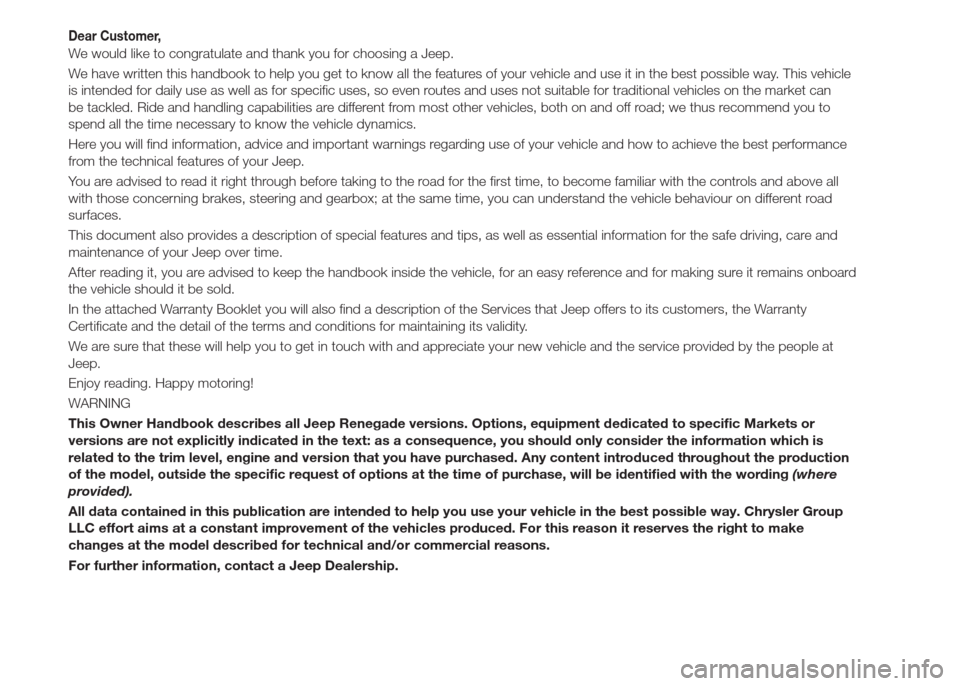
Dear Customer,
We would like to congratulate and thank you for choosing a Jeep.
We have written this handbook to help you get to know all the features of your vehicle and use it in the best possible way. This vehicle
is intended for daily use as well as for specific uses, so even routes and uses not suitable for traditional vehicles on the market can
be tackled. Ride and handling capabilities are different from most other vehicles, both on and off road; we thus recommend you to
spend all the time necessary to know the vehicle dynamics.
Here you will find information, advice and important warnings regarding use of your vehicle and how to achieve the best performance
from the technical features of your Jeep.
You are advised to read it right through before taking to the road for the first time, to become familiar with the controls and above all
with those concerning brakes, steering and gearbox; at the same time, you can understand the vehicle behaviour on different road
surfaces.
This document also provides a description of special features and tips, as well as essential information for the safe driving, care and
maintenance of your Jeep over time.
After reading it, you are advised to keep the handbook inside the vehicle, for an easy reference and for making sure it remains onboard
the vehicle should it be sold.
In the attached Warranty Booklet you will also find a description of the Services that Jeep offers to its customers, the Warranty
Certificate and the detail of the terms and conditions for maintaining its validity.
We are sure that these will help you to get in touch with and appreciate your new vehicle and the service provided by the people at
Jeep.
Enjoy reading. Happy motoring!
WARNING
This Owner Handbook describes all Jeep Renegade versions. Options, equipment dedicated to specific Markets or
versions are not explicitly indicated in the text: as a consequence, you should only consider the information which is
related to the trim level, engine and version that you have purchased. Any content introduced throughout the production
of the model, outside the specific request of options at the time of purchase, will be identified with the wording(where
provided).
All data contained in this publication are intended to help you use your vehicle in the best possible way. Chrysler Group
LLC effort aims at a constant improvement of the vehicles produced. For this reason it reserves the right to make
changes at the model described for technical and/or commercial reasons.
For further information, contact a Jeep Dealership.
Page 4 of 212

READ THIS CAREFULLY
REFUELLING
Petrol engines: only refuel with unleaded petrol with octane rating (RON) not less than 95 in compliance with the European specification
EN228. Do not use petrol containing methanol or ethanol E85. Using these mixtures may cause misfiring and driving issues, as well as
damage fundamental components of the supply system.
Diesel engines: refuel only with diesel fuel conforming to the European specification EN590. The use of other products or mixtures may
damage the engine beyond repair and consequently invalidate the warranty, due to the damage caused.
For further details on the use of the correct fuel see paragraph "Refuelling the vehicle" in the "Starting and driving" chapter.
STARTING THE ENGINE
Versions with manual gearbox (petrol engines): make sure that the parking brake is engaged; set the gear lever to neutral, fully depress
the clutch pedal without pressing the accelerator, then bring the ignition device to AVV or press the ignition device button and release the
key or the button as soon as the engine has started.
Versions with manual gearbox (diesel engines): make sure that the parking brake is engaged; set the gear lever to neutral, fully depress
the clutch pedal without pressing the accelerator, then bring the ignition device to MAR and wait for warning lights
andto switch
off. Bring the ignition device to AVV or press the ignition device button and finally release the key or the button as soon as the engine has
started.
Versions with automatic transmission: make sure that the parking brake is engaged and that the gear lever is in P (Park) or N (Neutral),
fully depress the brake pedal, then bring the ignition device to AVV or press the ignition device button.
PARKING ON FLAMMABLE MATERIAL
The catalytic converter develops high temperatures during operation. Do not park the vehicle on grass, dry leaves, pine needles or other
flammable material: fire hazard.
RESPECTING THE ENVIRONMENT
The vehicle is fitted with a system that carries out a continuous diagnosis of the emission-related components in order to help protect the
environment.
ELECTRICAL ACCESSORIES
If, after buying the vehicle, you decide to add electrical accessories (with the risk of gradually draining the battery), contact a Jeep Dealership.
They can calculate the overall electrical requirement and check that the vehicle's electric system can support the required load.
SCHEDULED SERVICING
Correct maintenance of the vehicle is essential for ensuring that it maintains its performance and its safety features, its environmental
friendliness and low running costs unchanged in time.
Page 5 of 212
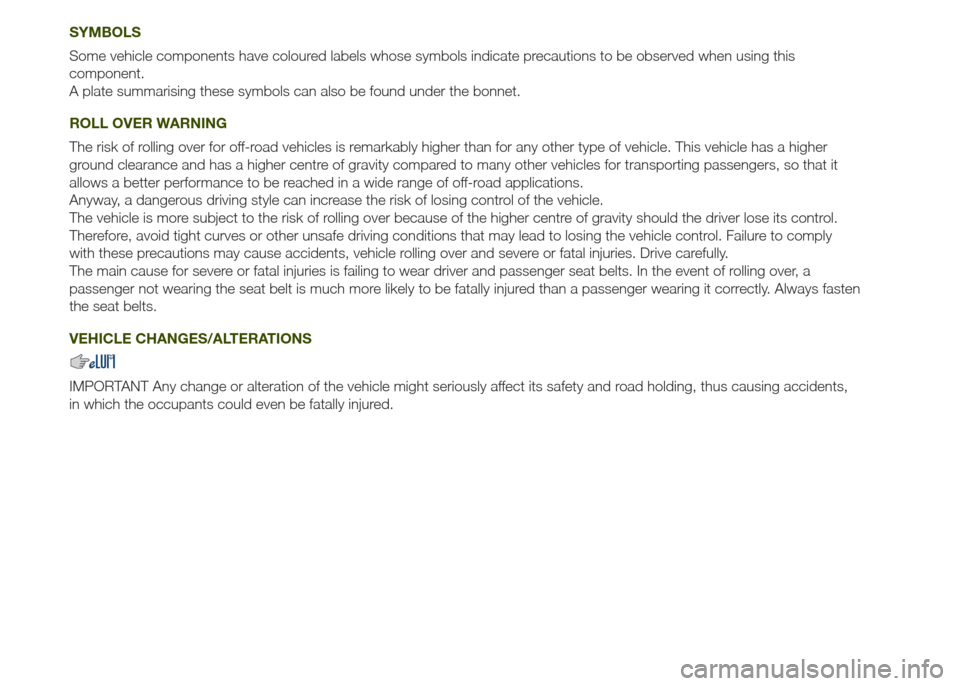
SYMBOLS
Some vehicle components have coloured labels whose symbols indicate precautions to be observed when using this
component.
A plate summarising these symbols can also be found under the bonnet.
ROLL OVER WARNING
The risk of rolling over for off-road vehicles is remarkably higher than for any other type of vehicle. This vehicle has a higher
ground clearance and has a higher centre of gravity compared to many other vehicles for transporting passengers, so that it
allows a better performance to be reached in a wide range of off-road applications.
Anyway, a dangerous driving style can increase the risk of losing control of the vehicle.
The vehicle is more subject to the risk of rolling over because of the higher centre of gravity should the driver lose its control.
Therefore, avoid tight curves or other unsafe driving conditions that may lead to losing the vehicle control. Failure to comply
with these precautions may cause accidents, vehicle rolling over and severe or fatal injuries. Drive carefully.
The main cause for severe or fatal injuries is failing to wear driver and passenger seat belts. In the event of rolling over, a
passenger not wearing the seat belt is much more likely to be fatally injured than a passenger wearing it correctly. Always fasten
the seat belts.
VEHICLE CHANGES/ALTERATIONS
IMPORTANT Any change or alteration of the vehicle might seriously affect its safety and road holding, thus causing accidents,
in which the occupants could even be fatally injured.
Page 6 of 212
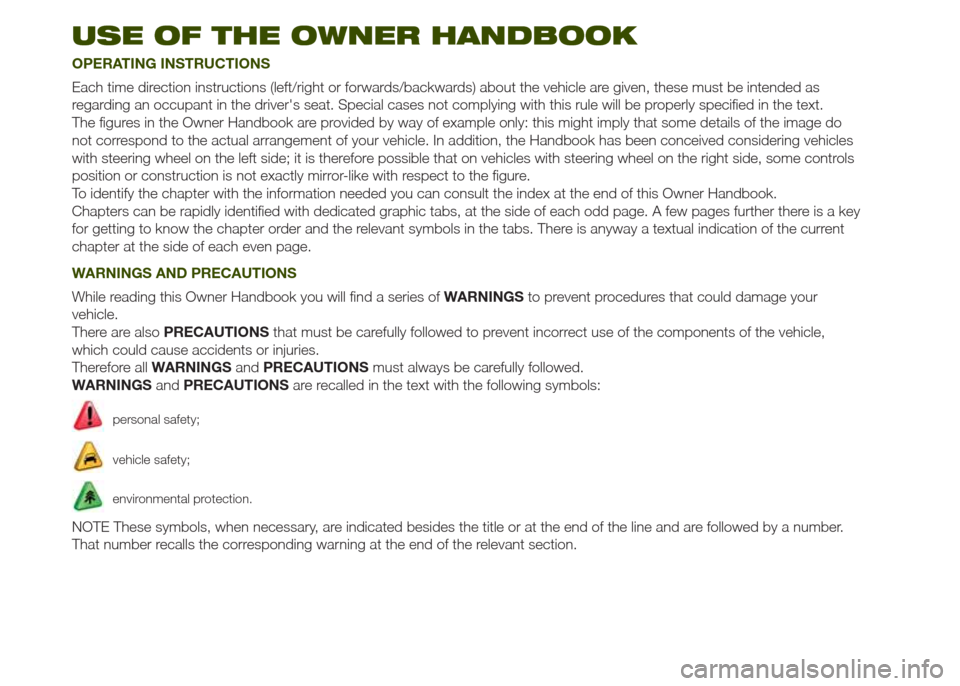
USE OF THE OWNER HANDBOOK
OPERATING INSTRUCTIONS
Each time direction instructions (left/right or forwards/backwards) about the vehicle are given, these must be intended as
regarding an occupant in the driver's seat. Special cases not complying with this rule will be properly specified in the text.
The figures in the Owner Handbook are provided by way of example only: this might imply that some details of the image do
not correspond to the actual arrangement of your vehicle. In addition, the Handbook has been conceived considering vehicles
with steering wheel on the left side; it is therefore possible that on vehicles with steering wheel on the right side, some controls
position or construction is not exactly mirror-like with respect to the figure.
To identify the chapter with the information needed you can consult the index at the end of this Owner Handbook.
Chapters can be rapidly identified with dedicated graphic tabs, at the side of each odd page. A few pages further there is a key
for getting to know the chapter order and the relevant symbols in the tabs. There is anyway a textual indication of the current
chapter at the side of each even page.
WARNINGS AND PRECAUTIONS
While reading this Owner Handbook you will find a series ofWARNINGSto prevent procedures that could damage your
vehicle.
There are alsoPRECAUTIONSthat must be carefully followed to prevent incorrect use of the components of the vehicle,
which could cause accidents or injuries.
Therefore allWARNINGSandPRECAUTIONSmust always be carefully followed.
WARNINGSandPRECAUTIONSare recalled in the text with the following symbols:
personal safety;
vehicle safety;
environmental protection.
NOTE These symbols, when necessary, are indicated besides the title or at the end of the line and are followed by a number.
That number recalls the corresponding warning at the end of the relevant section.
Page 7 of 212
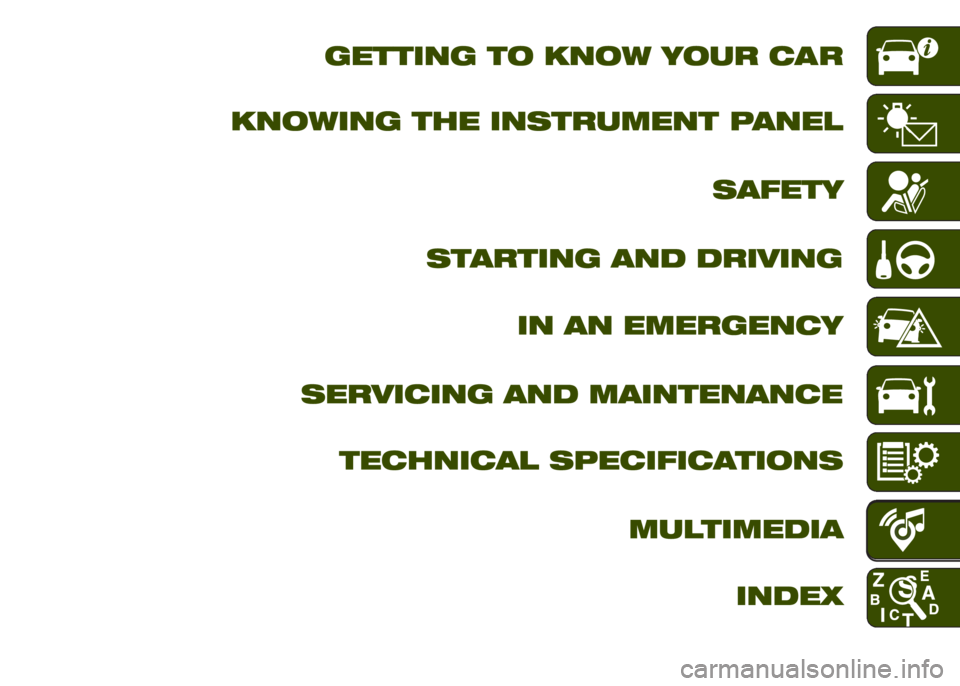
Page 8 of 212
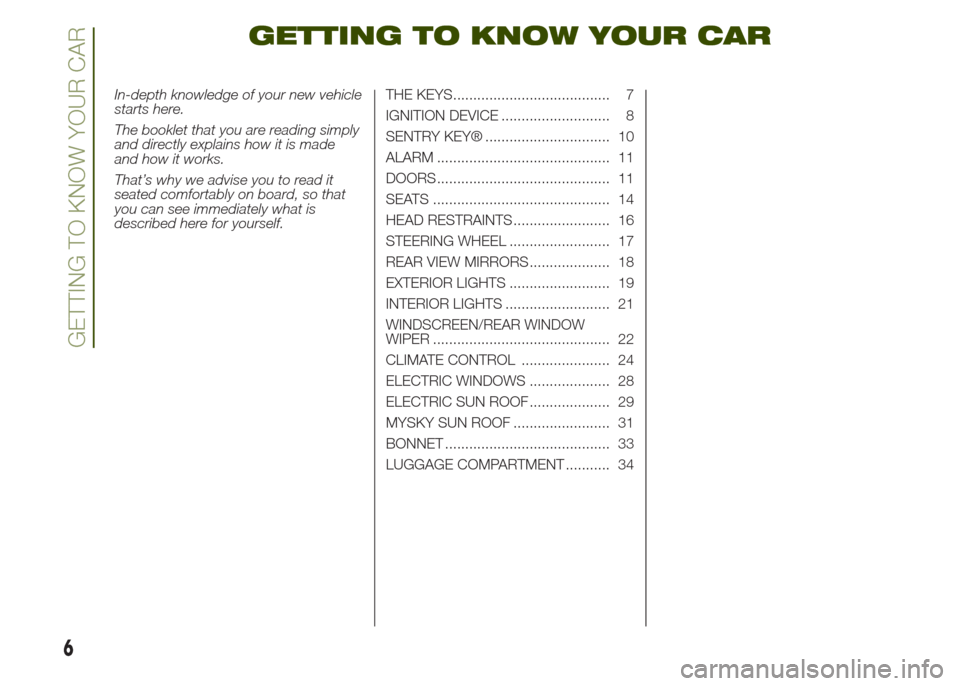
GETTING TO KNOW YOUR CAR
In-depth knowledge of your new vehicle
starts here.
The booklet that you are reading simply
and directly explains how it is made
and how it works.
That’s why we advise you to read it
seated comfortably on board, so that
you can see immediately what is
described here for yourself.THE KEYS....................................... 7
IGNITION DEVICE ........................... 8
SENTRY KEY® ............................... 10
ALARM ........................................... 11
DOORS ........................................... 11
SEATS ............................................ 14
HEAD RESTRAINTS ........................ 16
STEERING WHEEL ......................... 17
REAR VIEW MIRRORS .................... 18
EXTERIOR LIGHTS ......................... 19
INTERIOR LIGHTS .......................... 21
WINDSCREEN/REAR WINDOW
WIPER ............................................ 22
CLIMATE CONTROL ...................... 24
ELECTRIC WINDOWS .................... 28
ELECTRIC SUN ROOF .................... 29
MYSKY SUN ROOF ........................ 31
BONNET ......................................... 33
LUGGAGE COMPARTMENT ........... 34
6
GETTING TO KNOW YOUR CAR
Page 9 of 212
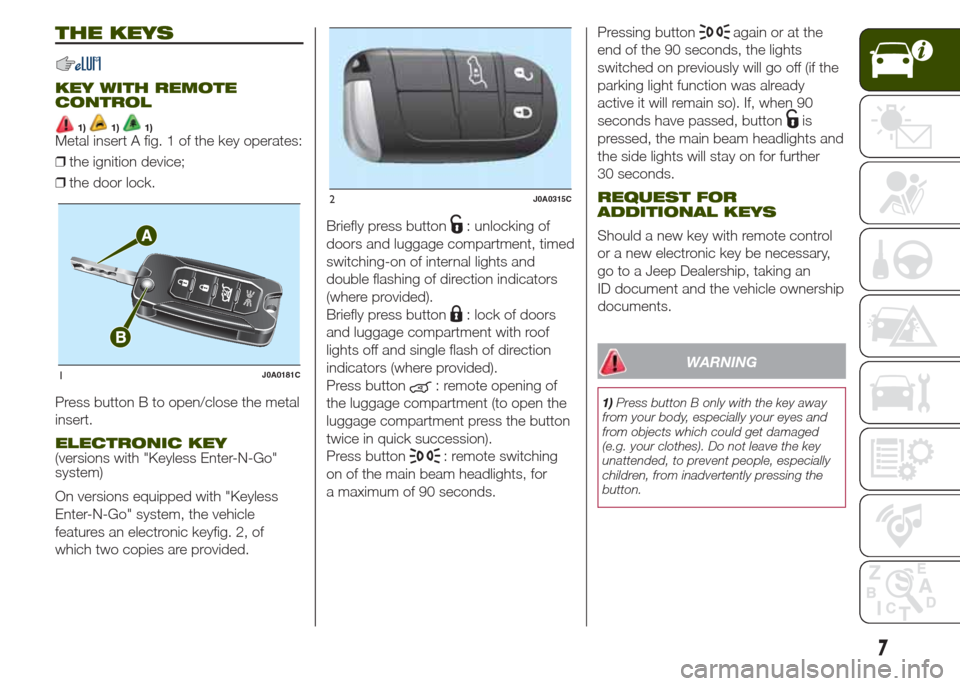
THE KEYS
KEY WITH REMOTE
CONTROL
1)1)1)Metal insert A fig. 1 of the key operates:
❒the ignition device;
❒the door lock.
Press button B to open/close the metal
insert.
ELECTRONIC KEY(versions with "Keyless Enter-N-Go"
system)
On versions equipped with "Keyless
Enter-N-Go" system, the vehicle
features an electronic keyfig. 2, of
which two copies are provided.Briefly press button
: unlocking of
doors and luggage compartment, timed
switching-on of internal lights and
double flashing of direction indicators
(where provided).
Briefly press button
: lock of doors
and luggage compartment with roof
lights off and single flash of direction
indicators (where provided).
Press button
: remote opening of
the luggage compartment (to open the
luggage compartment press the button
twice in quick succession).
Press button
: remote switching
on of the main beam headlights, for
a maximum of 90 seconds.Pressing button
again or at the
end of the 90 seconds, the lights
switched on previously will go off (if the
parking light function was already
active it will remain so). If, when 90
seconds have passed, button
is
pressed, the main beam headlights and
the side lights will stay on for further
30 seconds.
REQUEST FOR
ADDITIONAL KEYS
Should a new key with remote control
or a new electronic key be necessary,
go to a Jeep Dealership, taking an
ID document and the vehicle ownership
documents.
WARNING
1)Press button B only with the key away
from your body, especially your eyes and
from objects which could get damaged
(e.g. your clothes). Do not leave the key
unattended, to prevent people, especially
children, from inadvertently pressing the
button.
1J0A0181C
2J0A0315C
7
Page 10 of 212
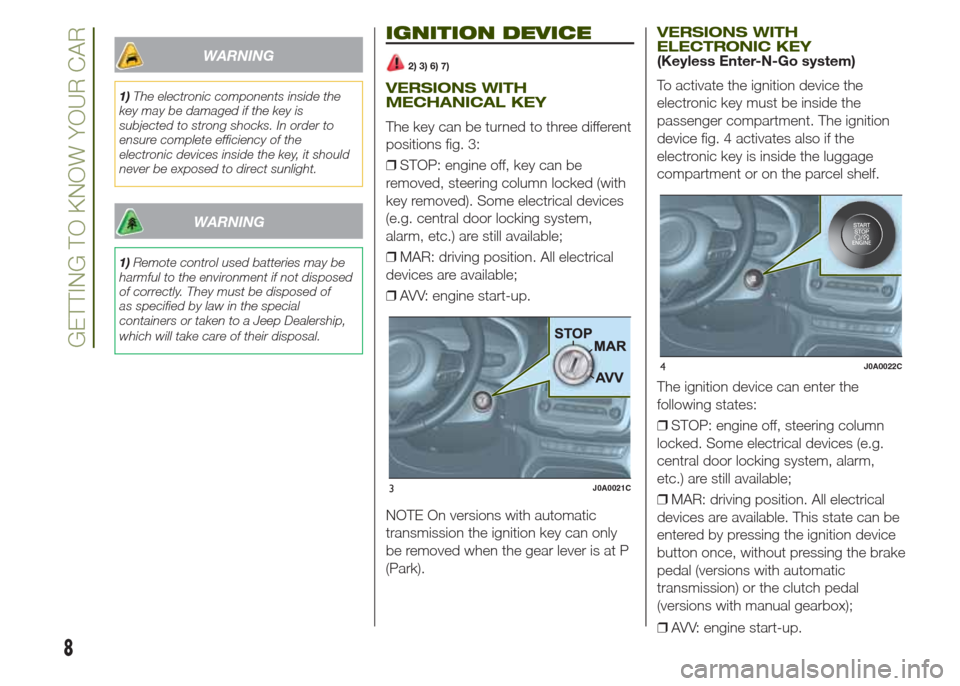
WARNING
1)The electronic components inside the
key may be damaged if the key is
subjected to strong shocks. In order to
ensure complete efficiency of the
electronic devices inside the key, it should
never be exposed to direct sunlight.
WARNING
1)Remote control used batteries may be
harmful to the environment if not disposed
of correctly. They must be disposed of
as specified by law in the special
containers or taken to a Jeep Dealership,
which will take care of their disposal.
IGNITION DEVICE
2) 3) 6) 7)
VERSIONS WITH
MECHANICAL KEY
The key can be turned to three different
positions fig. 3:
❒STOP: engine off, key can be
removed, steering column locked (with
key removed). Some electrical devices
(e.g. central door locking system,
alarm, etc.) are still available;
❒MAR: driving position. All electrical
devices are available;
❒AVV: engine start-up.
NOTE On versions with automatic
transmission the ignition key can only
be removed when the gear lever is at P
(Park).
VERSIONS WITH
ELECTRONIC KEY
(Keyless Enter-N-Go system)
To activate the ignition device the
electronic key must be inside the
passenger compartment. The ignition
device fig. 4 activates also if the
electronic key is inside the luggage
compartment or on the parcel shelf.
The ignition device can enter the
following states:
❒STOP: engine off, steering column
locked. Some electrical devices (e.g.
central door locking system, alarm,
etc.) are still available;
❒MAR: driving position. All electrical
devices are available. This state can be
entered by pressing the ignition device
button once, without pressing the brake
pedal (versions with automatic
transmission) or the clutch pedal
(versions with manual gearbox);
3J0A0021C
4J0A0022C
8
GETTING TO KNOW YOUR CAR
❒AVV: engine start-up.